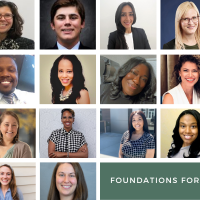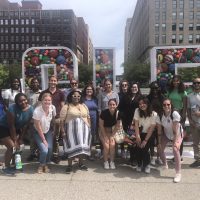From funding early experimental research to driving biomedical commercialization to partnering in a rapid response to the COVID-19 pandemic, the Cleveland Foundation has a long history of supporting innovations in health care. Since our founding in 1914, promoting the health and wellbeing of Greater Clevelanders has been among our chief priorities.
Emergency aid to Cleveland’s Forest City Hospital
Forest City Hospital, a 100-bed general medical center built by a group of African American physicians who wanted to practice in a hospital free of race restrictions, survived its difficult first year of operation with the help of the foundation’s $35,000 emergency grant. Its financial footing regained, Forest City served the residents of Cleveland’s far east side for 20 years. When the hospital closed, its assets were transferred to the new Forest City Hospital Fund at the Cleveland Foundation. In 1981, fund monies helped to launch a capital campaign to replace the antiquated mansion housing the Eliza Bryant Center for the frail elderly in Hough with a new $4.5 million facility that doubled the nursing home’s capacity.
Experimental Polio research and vaccines
In 1933, one of the Cleveland Foundation’s very first medical research grants was awarded to support a City Hospital physician’s study of the causes of poliomyelitis. John A. Toomey, M.D., who was also a professor of clinical pediatrics and contagious diseases at the Western Reserve University medical school, continued to receive foundation backing through the early 1940s. The pre-eminence of his medical practice was a contributing factor in City Hospital’s designation by the National Foundation for Infantile Paralysis as a national respiratory care center in the 1950s.
Later, in 1962, a foundation grant helped Cleveland’s Academy of Medicine to launch what was at the time the largest mass polio immunization program ever undertaken in the world. Approximately 1.5 million Greater Clevelanders received the Sabin oral vaccine during the immunization campaign, preventing untold suffering and medical expenditures.
Joining the early battle against AIDS
In the period before early screening tests and improved antiretroviral treatments transformed AIDS into a long-term chronic disease for most patients in the United States, the Cleveland Foundation and our partners advocated for preventative education and proactive health care programs to lessen the disease’s impact in Cuyahoga County. In 1983, foundation staff met with the City of Cleveland’s health commissioner and encouraged the city to move forward with planning for a widespread education program targeted at high-risk groups. In 1986, the foundation followed up with a $67,000 grant for the city’s first public awareness campaign. These initiatives stood in contrast to the attitude adopted in other peer Midwestern cities, where AIDS was still misunderstood and not perceived as a major public health threat. The Cleveland Foundation joined The George Gund Foundation in pushing for Cleveland’s inclusion in a demonstration project initiated by the Ford Foundation to stimulate a community-wide attack on the disease in nine metropolitan areas. Ford’s National Community AIDS Partnership Project was based on Cleveland’s response to the epidemic. The Cleveland and Gund Foundations raised $1 million for project grants that helped to pave the way for what became a collaborative, broad-based response to AIDS in Greater Cleveland.
With continuing financial support from the two foundations, a Citizens Committee on AIDS/HIV was convened in 1992. The 13-member committee, which included a number of persons living with AIDS/HIV, reviewed service and funding gaps and developed an action plan that led to the AIDS Funding Collaborative (AFC). Supported by the Cleveland and Gund foundations, the Cuyahoga County Commissioners, United Way Services and the National AIDS Fund, AFC awarded grants to implement the citizen committee’s wide-ranging recommendations and encourage the community’s coordination of services. Since its inception in 1994, AFC has distributed more than $8 million to private and public-sector providers for research, treatment and related social services.
Encouraging collaboration on medical research and education
The foundation has been instrumental in advancing medical care, research and education through strategic support across all Greater Cleveland’s hospital systems and medical schools. Foundation support helped establish a pediatric non-invasive care unit at University Hospitals, and the foundation was a key convener advancing partnerships between UH, Cleveland Clinic, MetroHealth Medical Center and Case Western Reserve University.
In 1991, the foundation formed the Study Commission on Medical Research and Education, a panel of nationally prominent medical administrators and corporate executives chaired by William G. Anlyan, M.D., chancellor for health at Duke University. The commission was charged with recommending possible avenues of collaboration among University Hospitals, the Cleveland Clinic, the school of medicine at Case Western Reserve University (CWRU) and Metropolitan General Hospital, the precursor of MetroHealth, Cleveland’s public hospital system. Published in the summer of 1992, the commission’s final report raised awareness of the promise of biotechnology as an economic driver for the region. A decade later, the foundation provided the first private funding for BioEnterprise, a state-supported collaboration between University Hospitals, the Cleveland Clinic and CWRU aimed at facilitating the commercialization of locally developed bioscience technologies and fostering the growth of biomedical companies in northeastern Ohio. With significant ongoing support from the foundation and other private funders, BioEnterprise has created, recruited or grown more than 170 biomedical companies to date, and those companies have in turn attracted more than $1.5 billion in new venture capital. More than 500 technology transfer deals have been arranged with industry partners by BioEnterprise.
The foundation has also committed to supporting medical education in Northeast Ohio. Its $10 million grant in 2013 supported the construction of Case Western Reserve University’s new School of Medicine on Cleveland Clinic’s campus. The collaboration between the hospital and university will help both anchor institutions attract top up-and-coming medical talent and continue to help make Northeast Ohio a top destination for world-class medical care and biomedical innovation. The foundation’s $5.5 million grant to Cleveland State University in support of the Northeast Ohio Medical University (NEOMED)-CSU Partnership for Urban Health will help recruit and train medical students who reflect the cultural makeup of the communities they serve, ensuring a diverse pipeline of top-notch medical talent in Northeast Ohio.
A rapid response to COVID-19
Within days of the first reported case of COVID-19 in Ohio in March 2020, the Cleveland Foundation convened partners across the philanthropic, nonprofit, government and corporate sectors to establish the Greater Cleveland COVID-19 Rapid Response Fund. In its first two phases, the Rapid Response Fund raised more than $20 million and made grants to 675 nonprofit groups and organizations in Cuyahoga, Lake and Geauga counties working to help their communities cope with the impact of the pandemic. The Rapid Response Fund also supported efforts to increase access among underserved populations to Ohio’s Mass Vaccination Clinic at Cleveland State University’s Wolstein Center in the spring of 2021. More than 255,000 doses of COVID-19 vaccine were administered at the clinic during its 12-week operation.
The Rapid Response Fund launched its Phase III efforts in September 2021 as the Funders Collaborative on COVID Recovery (FCCR). The FCCR’s ongoing work shifts the focus from rapid response grantmaking to long-term COVID recovery, using resources to increase vaccine access and uptake; address homelessness; advocate for long-term policy change that promotes economic wellbeing and equity; support grassroots advocacy efforts; and build resilience in the nonprofit community. You can learn more about the FCCR here.



